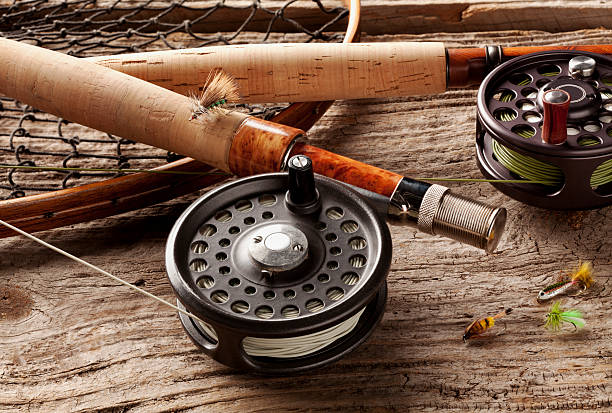
If you’ve ever watched someone casting a long, looping line across a river, you’ve seen fly fishing in action. It’s a style of fishing rooted in patience, skill, and a love for wild waters. And here in the White Lake area — Montague, Whitehall, and the surrounding rivers — you don’t have to go far to experience it.
In this edition of our Hunters and Anglers series, we’re taking a closer look at fly fishing: what makes it different, where to go, what to expect on the water — and we’ll feature some local action from Michigan angler Cayden Richie, who recently shared a great video of fly fishing one of our local rivers.
What Is Fly Fishing?
Fly fishing is a unique method of fishing that uses a lightweight “fly” — an artificial imitation of insects or baitfish — to lure fish. The technique is all about the cast: instead of using the weight of a lure to pull your line, fly fishing uses a weighted line to propel the nearly weightless fly.
The result? A graceful, natural presentation that mimics real food sources — making it an ideal way to target wary fish like trout in clear rivers.
How Is It Different from Traditional Fishing?
- Casting: Fly fishing is about casting line, not lure weight. You’ll often see smooth, looping casts through the air.
- Gear: Fly rods and reels are designed to handle lightweight flies, with specialized lines and leaders.
- Presentation: Rather than retrieving lures or soaking bait on the bottom, fly anglers often fish on or just below the surface, matching insect hatches or drifting flies naturally.
- Technique: More active — it involves moving, reading the water, and constantly adjusting.
Where Do You Typically Fish From — Boat or Land?
Locally, it depends on where you fish:
- White River: Most fly anglers fish from shore or by wading. There are many public access points where you can walk in or carefully wade.
- White Lake and River Mouth: If fly fishing the lake, anglers typically use boats or kayaks to reach productive shallows or structures. The river mouth offers a mix — wading works during lower flows.
In Cayden Richie’s recent local video, he’s seen hiking into a creek and fishing entirely on foot — navigating challenging, brushy terrain and picking pockets of fishable water.
“After a longer hike than I expected… first glance at it, it’s definitely going to be tough,” Cayden shares in his video. “Fishing all kinds of obstacles… but I’ve done decent in stuff like this before.”
What Gear Do You Use?
Fly fishing setups are simple but specialized:
- Rod: A 9-foot rod. For trout, 4–6 weight; for salmon or steelhead, 7–8 weight.
- Reel: A balanced reel with a smooth drag system.
- Line: Floating line for dry flies; sinking tips or full sinking for streamers.
- Leader & Tippet: Tapered line to help present your fly delicately.
- Flies: Hand-tied imitations of insects, minnows, or eggs. Around here, top flies include stoneflies, caddis, mayflies, egg patterns, and streamers.
In Cayden’s outing, he’s targeting brook trout and brown trout using dry flies:
“Finally got our hands on one… beautiful Eastern brookie — took me about eight tries but finally got him on the dry,” he reports after landing a colorful trout.
When Is the Best Time to Fly Fish?
White River and White Lake offer year-round opportunities, but here’s when to go:
- Spring (March–May): Prime for steelhead and excellent trout fishing on natural hatches.
- Summer (June–August): Great for brook and brown trout in cooler river stretches; bass and panfish in White Lake.
- Fall (September–November): Salmon runs begin in the river, followed by steelhead; resident trout feed heavily.
- Winter (December–February): Slower but still offers steelhead and trout opportunities for hearty anglers.
In Cayden’s video, he highlights hot summer fishing — nearly 90 degrees — and notes the importance of getting fish quickly back in the water to reduce stress:
“Definitely make sure to get the fish back in the water as quick as possible.”
What Types of Fish Can You Catch?
Expect to find:
- White River: Steelhead, Chinook salmon, brook trout, brown trout, coho salmon.
- White Lake: Bass (largemouth and smallmouth), bluegill, crappie, perch, pike, brown trout, walleye.
Cayden’s successful trip brings in both brookies and brown trout, including one of the biggest browns he’s landed from that river:
“That’s a freaking good fish… biggest fish I’ve ever caught out of this stream.”
Final Cast
Fly fishing in the White Lake area is more than a way to catch fish — it’s a way to experience the rivers and lakes that shape our community. Whether you’re chasing steelhead in spring or casting dries for brook trout on a warm summer evening, it’s an angling adventure that connects you deeply with the water.
And if Cayden Richie’s recent outing proves anything, it’s that even a tough day on the river can turn into a night to remember.
“Ended up being a freaking good night… can’t complain about that.”
So grab a rod, tie on a fly, and give it a shot — right here in our own backyard.
Kara Raeth is the DMM Service Lead at CatchMark Technologies, bringing over 15 years of experience in web development, customer service, and project management. She joined the company in 2019 as a Web Developer and has since expanded her role to include office management, accounts receivable and payable, and project management. Kara proudly served in the U.S. Army, where she specialized in signal and communication intelligence—developing a strong foundation in secure communication and technical systems. Her combined military background and digital expertise make her a vital asset to CatchMark’s digital marketing and media operations.
Must See
-


Latest News
/ 14 hours agoDiscover Fly Fishing in the White Lake Area
If you’ve ever watched someone casting a long, looping line across a river, you’ve...
By Kara Raeth -


Community
/ 1 day agoHealthy Roots Brings Wholesome Living and Heartfelt Support to Downtown Whitehall
Healthy Roots is more than just a health food store—it’s a place of purpose,...
By Amy Yonkman -


Opinion
/ 3 days agoThe Decline of Free Speech in Educational Institutions: A Threat to Open Discourse
The university auditorium was packed but free speech was tabled. A guest speaker, invited...
By Brent Raeth















